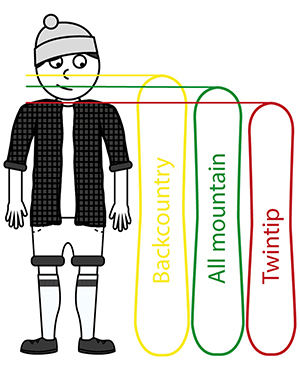Investing in Snowboards
Your snowboard selection will principally depend on your expertise and your enthusiasm for navigating pistes, taking on park challenges, or exploring off-piste terrains. Foot size, weight, and height are also crucial factors to bear in mind.
Which Snowboard Length and Width are Best?
- Snowboard Length is influenced by your preferred terrain and height. Generally, a snowboard should extend from somewhere around the shoulder to the midpoint of your head. Longer boards are typically advised for backcountry/off-piste adventures, while shorter ones are more suitable for freestyle activities. A mid-sized board offers versatility for all-mountain riding.
For novices and children, opting for a slightly shorter board is generally recommended to enjoy a straightforward and pleasurable experience on the slopes. You can find these sizing guides on individual snowboard product pages if available.
More recently, brands have introduced model-specific sizing charts based on weight. This method is likely the most effective for selecting the appropriate snowboard length. - Snowboard Width is categorised into Standard and Wide. Wide boards are suggested for those with shoe size 44 and over, though junior wide boards do not follow this rule.

Three Categories of Snowboards
- Twintip snowboards are ideal for park activities and tricks, yet are enjoyable on the piste too. The board is perfectly symmetrical at both ends, with centrally positioned bindings, facilitating the ease of riding and landing tricks in both directions.
- All Mountain snowboards are the most adaptable. Although their design resembles that of a twintip board, the bindings, flex, and balance point are shifted towards the back. This type of board is an excellent choice for many, as it is apposite for all-mountain use, including piste, park, and off-piste locations.
- Backcountry: Crafted for deep powder off-piste, this snowboard type is akin to a surfboard in shape. Its expansive surface area ensures a smooth ride in deep snow.
Features of Snowboard Designs
Shape
- Directional: Designed to move in a single direction, typically on or off the piste. Its stiffer rear design enhances stability at elevated speeds.
- Twin: Characterised by a symmetrical front and back, making it perfect for tricks and park activities. Twin-shaped boards can be used in both directions.
- Directional Twin: A blend of both shapes, frequently designed for all-mountain and freestyle snowboarding.
Baseline Design
A snowboard's baseline (its bottom part) can vary and be camber, rocker, or flat. These styles are often mixed, depending on the intended use of the board.

- Rocker: Applicable when a snowboard has an upward curve at the front and/or back, making it excellent for powder and easy manoeuvres. Rocker minimises drag, proving to be reliable in park settings.
- Camber: The snowboard's nose and tail press downwards into the snow, increasing snow contact, and enhancing edge grip.
- Flat: Offers complete contact with the snow surface, delivering greater stability than a classic rocker while facilitating smooth turns.
